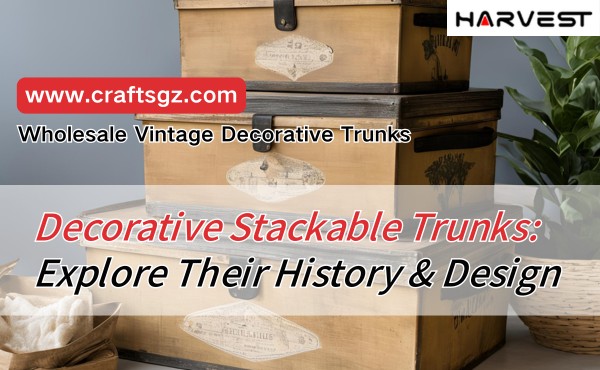A handmade wooden trunk is more than just a piece of furniture. It tells a story of skilled craftsmanship, patience, and love for natural materials. These wooden trunks are not made by machines in huge factories – they are carefully built by hand, one step at a time. In this blog, we’ll take you on a journey from the very first step of cutting the wood to the final step of shipping the trunk to its new home.
Let’s dive into the full process of how a handmade wooden trunk comes to life:
Step 1: Cutting the Wood and Building the Frame
Every handmade wooden trunk starts with raw wood boards. These boards are usually made from strong and durable wood like pine, oak, or teak. The first job is to cut the wood into different shapes and sizes. Each piece has a role; some will form the base, others the sides, the top, and even the corners.
Skilled carpenters use saws to cut the boards based on the trunk design. Once all the pieces are ready, they assemble them together like a puzzle. They use nails, screws, and wood glue to hold everything in place. This creates a wooden framework, which is the basic shape of the trunk.
At this stage, it may not look very fancy, but it’s a solid start.
Step 2: Coloring the Wood – Dying the Framework
Once the trunk’s shape is complete, the next step is to give it colour. This is done by applying wood dye to the surface. Dyeing helps the trunk match the style and tone the maker wants. Whether it’s a dark walnut finish or a light oak shade, the dye brings out the natural beauty of the wood grain.
The craftsmen apply the dye carefully using brushes or cloth. It takes practice to do it evenly, making sure there are no dark spots or light patches. After dyeing, the trunk is left to dry for a few hours before moving to the next step.
Step 3: Drying and Sanding for Smoothness
After dyeing, the wooden frameworks are taken outside to dry under the sun. This drying process happens in an open playground or yard. The natural sunlight helps set the colour and makes the wood dry properly.
Once dry, the trunk is still a bit rough to touch. That’s why the next step is sanding. Sandpaper is used to polish the entire surface of the trunk. This removes any rough spots, splinters, or small bumps. The goal is to make the trunk smooth and pleasant to touch.
Sanding is a slow and careful task, but it’s important. A well-sanded trunk not only looks better but also feels much nicer.
Step 4: Waxing to Make It Shine
Now that the surface is smooth, it’s time to add some shine. Craftsmen use floor wax or wood wax to polish the trunk. This is done by applying a thin layer of wax all over the wooden surface. Then they rub it in using soft cloths or brushes.
The wax not only adds a shiny finish but also protects the wood from dust and moisture. It gives the trunk a rich, glowing look that really brings out the wood grain and colour. This is when the handmade wooden trunk starts to look like a finished product.
Step 5: Final Quality Check and Packing
Before sending the trunk to customers, the team does a final Quality Control (QC) check. They look closely at each trunk to make sure everything is perfect—no scratches, no loose joints, and no colour problems. If anything is not right, they fix it on the spot.
Once the trunk passes the QC check, it’s time to pack it. The trunk is carefully wrapped in protective materials like foam, plastic, or bubble wrap. Then, it’s packed into a strong paper carton box to keep it safe during shipping.
Step 6: Shipping – From Workshop to the World
Now, the handmade wooden trunk is ready to leave the workshop. The packed boxes are loaded onto trucks and sent to the shipping terminal. From there, they are placed on ships that take them to customers around the world.
It’s an exciting moment. After all the hard work, the product is finally on its way to bring joy to someone’s home.

The Beauty of Handmade Craftsmanship
What makes a handmade wooden trunk special is the time, care, and attention that goes into every detail. Unlike factory-made furniture, these trunks are made by real people using traditional methods. Each piece is slightly different, which gives it character and uniqueness.
Older generations often train the craftsmen who build these trunks. They use simple tools, follow old techniques, and add their personal touches. It’s this human element that gives each trunk its own story.
Why Choose a Handmade Wooden Trunk?
There are many reasons why people love handmade wooden trunks:
- Durability: Made from solid wood, these trunks last for many years.
- Style: They bring a rustic and warm feel to any space.
- Versatility: Use them as coffee tables, storage boxes, or even bedside tables.
- Sustainability: Many makers use eco-friendly wood and natural materials.
- Uniqueness: No two handmade trunks are exactly the same.
When you buy one, you’re not just getting a piece of furniture – you’re supporting traditional craftsmanship and sustainable work.
Final Thoughts
The journey from idea to finished product is more than just a process—it’s about skill, patience, and pride. From cutting raw wood to applying the final wax polish, every step is done with care. The entire process may take days or even weeks, but the result is something timeless and meaningful.
Harvest’s handmade wooden trunks show true quality and creativity, bringing back the traditional craft in today’s busy world. When you select handmade, you are buying a product with a heart. And when the product is a handmade wooden trunk, you get something more than mere storage – you get a piece of the past.
If you’re looking for a furniture piece that tells a story, adds warmth to your space, and stands the test of time, a handmade wooden trunk might be the perfect choice.
Browse our full collection and learn more about the craft of hand-carved decorative wooden trunks and chests at Harvest.





















